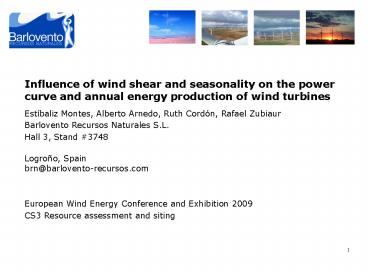Wind Profile Lidar Measurements over a Forest - PowerPoint PPT Presentation
1 / 15
Title:
Wind Profile Lidar Measurements over a Forest
Description:
Lidar has been evaluated as complementary equipment for power curve tests. INTRODUCTION ... LIDAR MEASUREMENTS. Validation of measurements (wind speeds, wind profile) ... – PowerPoint PPT presentation
Number of Views:46
Avg rating:3.0/5.0
Title: Wind Profile Lidar Measurements over a Forest
1
Influence of wind shear and seasonality on the
power curve and annual energy production of wind
turbines
Estíbaliz Montes, Alberto Arnedo, Ruth Cordón,
Rafael Zubiaur Barlovento Recursos Naturales
S.L. Hall 3, Stand 3748 Logroño,
Spainbrn_at_barlovento-recursos.com European
Wind Energy Conference and Exhibition 2009 CS3
Resource assessment and siting
2
OUTLINE
- Introduction
- Influence of wind shear on AEP
- Use of lidar for wind profile assessment
- Results
- Conclusion
3
INTRODUCTION
- Power curve function not only of horizontal wind
speed P(ws). - Other parameters influence the performance
- Wind shear, turbulence,
- Some of these parameters depend on atmospheric
stability. - The influence of wind shear and seasonality on
power curve has been investigated. - Experimental works Power curve tests at
different sites have been carried out, including
wind shear assessment. - The influence of wind shear and seasonality on
AEP results is assessed. - Lidar has been evaluated as complementary
equipment for power curve tests.
4
Seasonality of wind shear is well known
5
EXPERIMENT
Power curve tests at different sites
- Site 1. Flat terrain, near sea level, South of
Spain. - Site 2. Complex terrain, about 1000 m a.s.l.,
Centre of Spain. - Site 3. Near flat terrain, about 300 m a.s.l.
North of Spain.
Turbine power lt 1MW, 1-2 MW, gt 2MW Tests
according IEC 61400-12-1. Additional equipments
for the assessment of wind shear. Site 3 includes
also lidar measurements.
6
EXPERIMENT
Datasets have been split into subsets
- Category 1. a lt 0.12
- Category 2. 0.12 a lt 0.17
- Category 3. 0.17 a
Power curves and AEP have been calculated for
each Site, dataset and subset.
7
(No Transcript)
8
Similar AEP differences for three
sites. Influence of wind shear on power curve is
similar.
9
EXPERIMENT
- Results
- Better power performance for lower a Category
1. - Similar differences in AEP for three sites.
- Similar results for different turbine sizes.
- Wind Shear not the only cause of seasonal AEP
differences.
10
LIDAR MEASUREMENTS
The measurement plan at Site 3 includes
- Validation of measurements (wind speeds, wind
profile). - Filtering criteria development.
- Assessment of results.
11
LIDAR MEASUREMENTS
Validation of measurements
- Many uncorrelated data gt lidar filtering
necessary.
12
LIDAR MEASUREMENTS
Filtering criteria
- Cloudiness.
- Rain.
- Data availability at all levels.
13
LIDAR MEASUREMENTS
Assessment of results
- High correlation of wind speeds (lidar-mast).
- Slope aprox. 1
- Same wind shear results,
- But
- Low data availability.
VMAST,TH 1.002 VLIDAR,TH R20.94
14
CONCLUSIONS
- Wind shear influences the power curve,
- For the same hub height average wind speed,
- AEP is lower for big a values.
- Wind shear variations can be found at test
sites - by sector, by season, then
- Measurements of wind shear shall be included in
the tests. - Lidar measurements can be helpful, but
- lidar valid data availability need to be
improved. - Site specific power curves are needed for
- wind resource assessment.
15
CONSIDERATION
Power curve is used as a wind turbine
performance characteristic. The improvements in
the Power curve concept need to be consistent
with the wind resource assessment practices
measurements, wind field models, wake models.






























